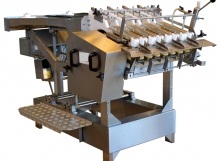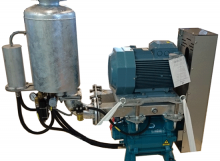FISH PROCESSING PLANT & MACHINERIES

It is suitable for smaller fish species like sardines and anchovy, or using in factories/vessels where space is limited. This Hopper and Elevator is steplessly regulated with a wheel, and consists of plastic carriers that will lift the fish onto a feeder or in-feed table (for manual feeding). The machine is designed to work with water or brine in the hopper.The elevator can be fitted with different sized buckets depending on the size of fish. It is delivered complete to be placed directly on the floor.
Feeders

This orientates the fish head first and belly down in four rows, side-by-side, Feeder wheels secure that the fish is fed synchronized with the fish pockets. The vibrating chutes of the machine are feeding the fish into pockets, after which the fish is continuing to the machine head and tail remover and filleting machine. Automatic Feeders are designed to supply the head-tail remover and the filleting machine.
Head Cutting Machines/ Nobbing Machine

Head/Tail cutting Machine accurately and efficiently removes the head and tail of the fish. Additional equipment is available for cutting the fish into pieces, gender sorting of herring, Vision-system for a less labor intense process. Stainless steel fish pockets carry the fish to precision measuring device that customize the position of the head cut and tail cut for each individual fish, achieving high yield.
Filleting Machines

The Filleting Machine accurately and efficiently removes the guts and bones of the fish, while cutting high-yield butterfly fillets. Additional equipment is available for cutting single fillets or cleaning the belly cavity by mechanical means. The machine can be used as a single module with manual feeding, or connected to a head/tail cutting module and Skinning Machine. The machine is working with around 310 fish per minute. Species handling capabilities include herring, mackerel, horse mackerel, blue whiting, and similar species. The machine can also be configured to process smaller fish, such as sardines, kilka and sardinella. The machines are made from all non-corrosive material.
Skinning Machine

The Skinning Machine accurately and efficiently removes skin and dorsal fin of the fish.The machine is working with around 300 fish per minute. Species handling capabilities include herring, horse mackerel, blue whiting, and similar species. The machines are made from all non-corrosive material.

For the processing of fish which are not scaled simple by-pass chutes are fitted in the four scaling channels, and the fish pass through the scaling machine without being processed. Scaling machine can be fitted with scaling tools for different types of fish. There are special tools to remove the hard scales on horse mackerel and tools the normal scales over the entire surface of the fish. The machine removes the scales without damaging the skin of the fish. The machines are made from all non-corrosive material.
Semi-Automatic Scaling Machine

The Semi-Automatic Scaling machine is a version of the scaling machine, but built as a stand-alone unit.
Knife Sharpening Machine

This machine is especially intended to sharpen the circular knifes used in fish and meat processing machines. The sharpening machines are an indispensible auxiliary since really sharp knives only guarantee the exact and clean results required by the practician. It is laid out for a considerably extended size range, gentle treatment of the material thanks to the lapping method, highest efficiency, sharpened knives are completely free from any burrs, designed for re-sharpening knives and for providing extremely worn blunt knives with exact chamfers again.
Fillet Conveyor

The conveyor is used for transportation of fillets to a container or packing line. The machine is working with around 300 fish per minute. The machines are made from all non-corrosive material.
Vacuum Unit

The Vacuum Unit is designed to eviscerate Pelagic fish. It is connected to the Nobbing machine. The vacuum unit sucks the innards from the connected fish processing machines into the vacuum tank. The tank is automatically emptied via a sludge pump when amount of offal in tank reaches maximum level. Depending on the size of the pump, the vacuum unit can be connected to up to four processing lines. For processing factories ashore, we recommend a water-re-circulation unit.
